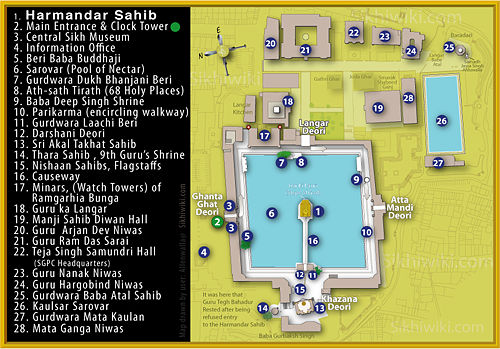
Back Arquitectura sij Spanish सिख स्थापत्यकला Hindi Architettura sikh Italian ਸਿੱਖ ਵਾਸਤੂਕਲਾ Punjabi سکھ طرز تعمیر PNB Arkitektura sikiste Albanian سکھ طرز تعمیر Urdu 錫克教建築 ZH-YUE
This article includes a list of general references, but it lacks sufficient corresponding inline citations. (January 2010) |
Sikh architecture
ਸਿੱਖ ਸਥਾਪਤਕ ਕਲਾ Sikh monuments and shrines | |
|---|---|
Cultural and religious architectural style | |
| Sikh Architectural Heritage | |
From top, left to right: Harmandir Sahib (Golden Temple), Amritsar; Gurudwara Bangla Sahib, Delhi; Fatehgarh Sahib Sarovar; Interior of Samadhi of Ranjit Singh, Lahore; Tarn Taran Sahib; Takht Sri Patna Sahib, Bihar; Hazur Sahib, Nanded; Kartarpur Sahib, Pakistan; Fateh Burj; Gurdwara Dera Sahib, Lahore; Gurdwara Janam Asthan, Nankana Sahib |
| Part of a series on |
| Sikhism |
|---|
 |

Sikh architecture is a distinctive style of architecture that developed under the Sikh Confederacy and later flourished during the Sikh Empire in the 18th and 19th centuries, primarily in the Punjab region.[1] Due to its progressive nature, Sikh architecture has continued to evolve over time, giving rise to several new branches and influencing various contemporary architectural styles.[2]Although Sikh architecture was originally developed as part of the religious and cultural expression within Sikhism, its aesthetic richness and symbolic elements have led to its adoption in many secular and non-religious buildings as well, admired for their beauty and structural harmony.[3] 300 years ago, Sikh architecture was distinguished for its many curves and straight lines; Keshgarh Sahib and the Harmandir Sahib (Golden Temple) are prime examples of traditional Sikh architecture.[4]
- ^ Singh, Khushwant (2004). A History of the Sikhs, Volume 1: 1469–1839. Oxford University Press. p. 331. ISBN 978-0-19-567308-1.
- ^ Subhash Parihar (2001). Golden Temple: History, Art, and Architecture. Aryan Books International. p. 102.
- ^ Malik Arshi (2012). Sikh Architecture. Himalaya Publishing House. p. 47.
- ^ Kartar Singh. "Sikh Architecture". SikhMuseum.com. Retrieved 2 July 2025.










